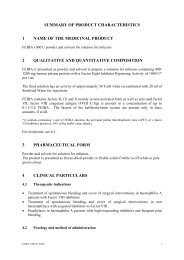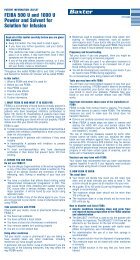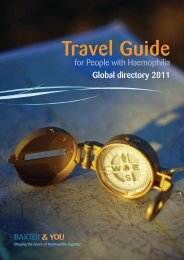Haemophilia in the Classroom - Haemophilia Care
Haemophilia in the Classroom - Haemophilia Care
Haemophilia in the Classroom - Haemophilia Care
- No tags were found...
Create successful ePaper yourself
Turn your PDF publications into a flip-book with our unique Google optimized e-Paper software.
A teacher’s guide to <strong>Haemophilia</strong>What is haemophilia?<strong>Haemophilia</strong> is an <strong>in</strong>herited genetic disorder, affect<strong>in</strong>g only about 6500 people <strong>in</strong> <strong>the</strong>UK, which can lead to <strong>in</strong>adequate clott<strong>in</strong>g of <strong>the</strong> blood <strong>in</strong> response to any form of<strong>in</strong>jury. The defective gene responsible controls <strong>the</strong> production of <strong>the</strong> prote<strong>in</strong>s <strong>in</strong> <strong>the</strong>blood, called clott<strong>in</strong>g factors, which control blood clot formation.How is haemophilia <strong>in</strong>herited?This gene is carried on <strong>the</strong> X sex chromosome. All females have twoX chromosomes, whereas males have one X and one Y chromosome.This difference determ<strong>in</strong>es <strong>the</strong> sex of <strong>the</strong> person.Because <strong>the</strong> haemophilia gene is on <strong>the</strong> X chromosome, it can be passed to <strong>the</strong>child by ei<strong>the</strong>r <strong>the</strong> fa<strong>the</strong>r or <strong>the</strong> mo<strong>the</strong>r. A man with haemophilia, married to awoman with normal X chromosomes, would have sons with his Y chromosomesand <strong>the</strong>ir mo<strong>the</strong>r’s X chromosomes, and would not <strong>the</strong>refore have haemophilia.His daughters would not ei<strong>the</strong>r, because although <strong>the</strong>y would have <strong>in</strong>herited hisdefective X chromosome, <strong>the</strong> normal one <strong>in</strong>herited from <strong>the</strong>ir mo<strong>the</strong>r wouldoverride <strong>the</strong> defect. However, <strong>the</strong>y would still be carriers of <strong>the</strong> condition, ableto pass it on to <strong>the</strong>ir children.Because a carrier has one normal and one defective X chromosome, <strong>the</strong>re is a50:50 chance of <strong>the</strong> haemophilia gene be<strong>in</strong>g passed to her children. As a resul<strong>the</strong>r sons will have a 50:50 chance of hav<strong>in</strong>g haemophilia, and her daughters a50:50 chance of be<strong>in</strong>g carriers.Because of this <strong>in</strong>heritance pattern, haemophilia runs <strong>in</strong> families. If you have a childwith haemophilia <strong>in</strong> your school, it is quite possible that any bro<strong>the</strong>rs or cous<strong>in</strong>she has will also be affected. Equally, any sisters could be carriers. Carriers mayoccasionally show signs of mild haemophilia <strong>the</strong>mselves, but this is unusual.It is <strong>the</strong>oretically possible for a girl to have full haemophilia, but this can happen onlyif she is <strong>the</strong> child of a carrier mo<strong>the</strong>r and a haemophiliac fa<strong>the</strong>r. As you might expect,this is quite rare.04








